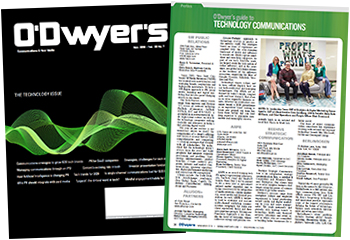 Dan O’Mahony Dan O’Mahony |
2018 and 2017 were banner years for IPOs in tech. DocuSign, Dropbox, Cloudera, Okta and many others entered the public markets and, despite a rocky six months for the market overall, are still trading well above their opening day prices.
On the other hand, 2019 has been a mixed bag for technology IPOs, to say the least. WeWork had a shocking fall from grace. The company delayed its IPO after investors showed big concerns about WeWork’s financials. Uber and Lyft have also had rocky debuts as well.
 |
| This article is featured in O'Dwyer's Nov. '19 Technology PR Magazine. |
All of this means it’s an incredibly challenging time if you’re an in-house communications person or team lead at a PR agency, and your company/client is preparing to go public. Yes, there’s more market skepticism, but the process is daunting even in the best of times: there’s new terminology, new stakeholders and much higher stakes than ever.
Employees can be emotional and hyper-aware about the process as well, considering a successful IPO could mean a new house, a year off, paying off debt or the beginning of a college fund for their kids. And of course, these recent negative headlines only intensify things further. No company wants to be the next WeWork.
There are also specific, legal consequences based on your decisions, with the potential for compromising or delaying the IPO if there are mistakes. This represents a major shift for most PR people in the startup world, who are used to pushing and shoving to get attention and ask for forgiveness later. So, if your executive team lets you know going public is close, how should you approach it? Where do you even start?
No two IPOs are the same. For a well-known brand like Airbnb, the challenge might be around explaining the company’s path to profitability. For a B2B-focused company like Databricks, the challenge is likely more on broadening awareness with the business press so they understand what the company actually does.
Regardless, messaging, timing, media outreach and other activities should all be high-touch and over-communicated to different teams and stakeholders to get buy-in.
That said, there are some broad-stroke guidelines that apply in more situations than not. Here are six lessons I learned working on Carbon Black’s IPO in 2018 and Okta’s IPO in 2017 (InkHouse worked with both companies as their agency of record through IPO):
Be ready. If your CEO tells you an IPO is a year out, keep tabs on the timing to make sure it doesn’t shift. Ask to speak with the Investor Relations team or legal team to get the full download. Find out when the first private filings, S-1 filing and roadshows are.
Even tentative dates are helpful, because once the company files its S-1, you’ll enter a complete quiet period—like a lockdown— and won’t be permitted to say anything. Knowing the dates well in advance will help you plan as much activity as possible before filing so no ideas or campaigns get delayed or canceled.
Be prepared to hear “no” (and to push back). Chances are, an IPO will mean more interactions with legal teams than you’ve ever had before. The good folks on your legal team are your friends, and you’ll want their sign-off on everything because they know what can get the company into hot water with the SEC.
That said, remember what their priorities are: they want to reduce risk. Saying “no” is the easiest way to do that. Try to push back when something seems overly restrictive and you’ll know what’s flexible and what is non-negotiable.
Don’t overlook social. Did you know that if an employee posts an article about your company’s rumored IPO, or even likes a story on Facebook, that could mean a flag from the SEC? Social media is the area with the biggest potential for employee sprawl. Be sure to train your employees on what they can and can’t be saying.
Build a great story. For a lot of companies, an IPO is an opportunity to get a higher level of interest from a different batch of reporters. It’s all the more important to have a great story, because now reporters will cover you whether or not you pitch them.
If all they have to go on is your S-1, then that’s what the coverage will look like. Or worse, they’ll pull messaging from an old press release. Go through your numbers in great detail to paint a better story that shows the company’s competitive moats, the value of its executive team and where you’re headed in the next ten years. That extra bit of context could mean the difference between straight numbers being reported on and a business feature with a strong narrative.
Educate reporters on your story today. If you know an IPO is coming and you’re not yet in a quiet period, you should be thinking about how to get your CEO and other spokespeople in front of lots more reporters.
Nagging misperceptions won’t go away through an IPO, they’ll intensify; during the IPO, more reporters will cover you organically than ever before. By law, your numbers are now publicly available, free of spin or context.
Particularly in the quiet period, when you won’t be able to comment on any- thing, your story is essenßtially out of your hands. This is why you should be hyper-aware of timing and briefing reporters well in advance so they’re well-informed about your company or client’s corporate story.
Remember it's a moment in time, not a finish line. Once an IPO is over and the excitement wears off—believe it or not, it will—you’ll be going back to the grind. Treat IPO day as an announcement and point in time—albeit a huge, much more complicated and longer-term moment in time—and start thinking about what the next six months will look like.
Make sure the story you tell on IPO day is one you’ll want to stick to three, six and 12 months out. Afterward, some of those IPO-day briefings will turn into long-term relationships and a chance to tell bigger, better stories.
An IPO is a huge achievement and milestone, but it’s just that, a milestone. Building for the long haul and treating this as the end of a chapter—as opposed to the end of a race—will put your communications program in a great position to benefit from all the goodness and excitement from a public exit.
***
Dan O’Mahony is Executive Vice President and San Francisco General Manager at InkHouse.


 Laura Anderson, who rose to VP/GM of global communications and events in a nearly 20 year stint at Intel, will take on the Americas technology chair at Burson following the completion of the BCW and H+K merger on July 1.
Laura Anderson, who rose to VP/GM of global communications and events in a nearly 20 year stint at Intel, will take on the Americas technology chair at Burson following the completion of the BCW and H+K merger on July 1. WE Communications has partnered with ROKK Solutions to form the WE ROKK AI service.
WE Communications has partnered with ROKK Solutions to form the WE ROKK AI service. In the dynamic world of modern business, effective communication is a pivotal tool for success across various industries. At Communications Strategy Group (CSG®), our expertise in embracing innovation in communication extends beyond traditional marketing strategies, paving the way for transformative industry-specific solutions.
In the dynamic world of modern business, effective communication is a pivotal tool for success across various industries. At Communications Strategy Group (CSG®), our expertise in embracing innovation in communication extends beyond traditional marketing strategies, paving the way for transformative industry-specific solutions. There are two types of tech PR professionals. Which one are you? And are C-suite executives making that decision for you?
There are two types of tech PR professionals. Which one are you? And are C-suite executives making that decision for you? While there’s an impulse to grab reporters’ attention with the newest industry-transforming tech product or service, a back-to-basics approach focused on telling the right stories to the right people is a far more successful way to ensure your technology campaign breaks through the clutter of today’s crowded tech landscape.
While there’s an impulse to grab reporters’ attention with the newest industry-transforming tech product or service, a back-to-basics approach focused on telling the right stories to the right people is a far more successful way to ensure your technology campaign breaks through the clutter of today’s crowded tech landscape.


 Have a comment? Send it to
Have a comment? Send it to 
No comments have been submitted for this story yet.